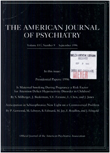REM sleep enhancement by bupropion in depressed men
Abstract
OBJECTIVE: The authors compared the effects of bupropion, fluoxetine, and cognitive behavior therapy on EEG sleep in depressed subjects. METHOD: All-night sleep EEG studies were performed before treatment and after partial or full remission on 18 men with depression diagnosed according to Research Diagnostic Criteria and randomly assigned to treatment with either bupropion (N = 7) or fluoxetine (N = 11). Response to these drugs was measured by changes in Hamilton Depression Rating Scale scores. Pre- and posttreatment EEG sleep study results before and after treatment with cognitive behavior therapy were also available for 18 men matched in age and severity of Hamilton depression scale score, and one-time EEG sleep measures were available for 36 men who were not depressed. RESULTS: REM latency was reduced and REM sleep percent and REM time increased after treatment in the depressed men given bupropion. These effects contrasted with the effects of fluoxetine and cognitive behavior therapy. CONCLUSIONS: This study represents the first report of an antidepressant medication that shortens REM latency and increases REM sleep. If confirmed, this finding may require a revision of our current understanding of the relation among depression, REM sleep, and anti-depressant mechanisms.
Access content
To read the fulltext, please use one of the options below to sign in or purchase access.- Personal login
- Institutional Login
- Sign in via OpenAthens
- Register for access
-
Please login/register if you wish to pair your device and check access availability.
Not a subscriber?
PsychiatryOnline subscription options offer access to the DSM-5 library, books, journals, CME, and patient resources. This all-in-one virtual library provides psychiatrists and mental health professionals with key resources for diagnosis, treatment, research, and professional development.
Need more help? PsychiatryOnline Customer Service may be reached by emailing [email protected] or by calling 800-368-5777 (in the U.S.) or 703-907-7322 (outside the U.S.).



